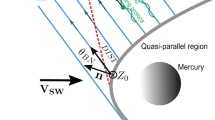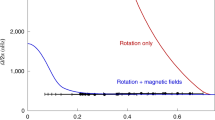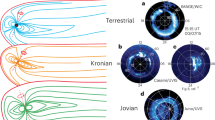Abstract
The interior rotation of the Sun is determined from rotational splittings of global oscillations of the Sun. The angular velocity distribution yields the minimum quadrupole moment coefficient J2 = 1.6×10−6. A physical angular velocity distribution will produce a larger J2 of the order of 5.0×10−6. These results are compared with general relativity and the nonsymmetric theory of gravitation. For J2 = 5.0×10−6 we find that using the radar tracking data for the orbits of Mercury and the minor planet Icarus, general relativity disagrees with the data by ≈2¼ standard deviations. The nonsymmetric gravitational theory can fit all the Solar System data, including the orbits of Mercury and Icarus, if the new post-newtonian parameter l⊙ = 3.1×103 km.
This is a preview of subscription content, access via your institution
Access options
Subscribe to this journal
Receive 51 print issues and online access
$199.00 per year
only $3.90 per issue
Buy this article
- Purchase on Springer Link
- Instant access to full article PDF
Prices may be subject to local taxes which are calculated during checkout
Similar content being viewed by others
References
Will, C. M. Theory and Experiment in Gravitation Physics (Cambridge University Press, 1981).
Dicke, R. H. & Goldenberg, H. M. Astrophys. J. Suppl., 27, 131–182 (1974).
Hill, H. A. & Stebbins, R. T. Astrophys. J. 200, 471–483 (1975).
Shapiro, I. I. et al. Phys. Rev. Lett. 28, 1594–1597 (1972).
Shapiro, I. I., Counselman, C. C. & King, R. W. Phys. Rev. Lett. 36, 555–558 (1976).
Anderson, J. D. et al. Acta astronautica 5, 43–61 (1978).
Moffat, J. W. Phys. Rev. D19, 3554–3558 (1979).
Moffat, J. W. in The Origin and Evolution of Galaxies (ed. de Sabbata, V. de) 127–180 (World Scientific, Singapore, 1982).
Moffat, J. W. J. math. Phys. 21, 1798–1801 (1980).
Moffat, J. W. Can. J. Phys. 59, 283–288; 1289 (1981).
Mann, R. B. & Moffat, J. W. Can. J. Phys. 59, 1592–1608 (1981).
Moffat, J. W. Phys. Rev. Lett. 50, 709–712 (1983).
Hill, H. A. The New Solar Physics (ed. Eddy, J. A.) 135–214 (Westview, Boulder, 1978).
Brookes, J. R., Isaak, G. R. & van der Raay, H. B. Nature 259, 92–95 (1976).
Severny, A. B., Kotov, V. A. & Tsap, T. T. Nature 259, 87–89 (1976).
Hill, H. A., Bos, R. J. & Goode, P. R. Phys. Rev. Lett. 49, 1794–1797 (1982).
Gough, D. O. Nature 298, 334–339 (1982).
Bos, R. J. & Hill, H. A. Solar Phys. 82, 89–102 (1983).
Christensen-Dalsgaard, J., Gough, D. O. & Morgan, J. G. Astr. Astrophys. 73, 121–128; 79, 260 (1979).
Shapiro, I. I. et al. Astr. J. 76, 588–606 (1971).
Author information
Authors and Affiliations
Rights and permissions
About this article
Cite this article
Campbell, L., McDow, J., Moffat, J. et al. The Sun's quadrupole moment and perihelion precession of Mercury. Nature 305, 508–510 (1983). https://doi.org/10.1038/305508a0
Received:
Accepted:
Issue Date:
DOI: https://doi.org/10.1038/305508a0
This article is cited by
-
Effect of the darkforce on the extra-anomalous apsidal precession of solar planets
Astrophysics and Space Science (2018)
-
Solar System’s Bounds on the Extra Acceleration of f(R, T) Gravity Revisited
International Journal of Theoretical Physics (2015)
-
On the Inherent Incompleteness of Scientific Theories
Activitas Nervosa Superior (2011)
-
The nonsymmetric Kaluza-Klein (Jordan-Thiry) theory in the electromagnetic case
International Journal of Theoretical Physics (1992)
-
General relativistic measurements with satellite laser ranging, lunar laser ranging and very long baseline interferometry
Il Nuovo Cimento C (1990)
Comments
By submitting a comment you agree to abide by our Terms and Community Guidelines. If you find something abusive or that does not comply with our terms or guidelines please flag it as inappropriate.



